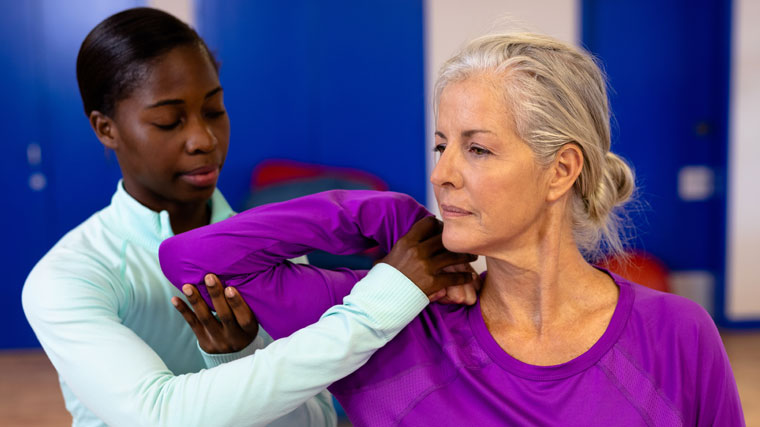- Bone and Joint Health
- Health Topics
- Joint Conditions/Injuries/Treatment
- Joint Pain/Pain Management
- Shoulder
How To Shoulder Less Pain

Answer a few questions and we'll provide you with a list of primary care providers that best fit your needs.
Over time, repetitive motion of the shoulder joint and the breakdown of soft tissue in and around the shoulder can lead to chronic pain, involving any of the components that make up the shoulder – bones, muscles, tendons, and ligaments.
Other common causes include injury to the tendon or rotator cuff and arthritis in the shoulder joint. Shoulder conditions fall into four main categories, according to the American Academy of Orthopaedic Surgeons (AAOS):
- Arthritis
- Fracture
- Instability
- Tendon inflammation (bursitis or tendinitis) or tendon tear
Rare causes of shoulder pain include tumors, infection, and nerve-related problems.
Types Of Shoulder Arthritis
Arthritis in the shoulder can limit mobility and cause pain, swelling, and stiffness. Four types of arthritis can affect the shoulder:
- Osteoarthritis. The most common form of arthritis, it wears away the cartilage from the ends of bones that form joints, causing the bones to grind together.
- Posttraumatic arthritis. This develops after an injury such as dislocation of the shoulder.
- Rheumatoid arthritis. An autoimmune disorder that causes your immune system to attack your body, rheumatoid arthritis causes swelling and pain in joint linings.
- Rotator cuff tear arthritis. This develops in the shoulder joint, over time, after a rotator cuff tear goes untreated.
Tests For Shoulder Pain
“Many shoulder problems can be diagnosed with a thorough physical examination by your doctor,” says Jordan Grilliot, DO, sports medicine physician and orthopedic surgeon. During the exam, you may tested for:
- Deformity or muscle weakness
- Physical abnormalities
- Range of motion and strength
- Swelling
- Tenderness
“Additionally, an x-ray may be taken during your visit to assess the bones around the shoulder. Often, this will provide good information regarding the root cause of your shoulder problem,” says Dr. Grilliot. “If a diagnosis is still not confirmed, further testing can be performed, such as MRI or CT scans. Additionally, ultrasound can be used to further find a diagnosis involving the rotator cuff.”
Nonsurgical Shoulder Pain Treatments
Some over-the-counter medications can alleviate the pain and stiffness of shoulder arthritis. Medications can also slow bone loss or alter the course of an inflammatory disease causing the pain, the Arthritis Foundation says.
"Physical therapy and exercise are also effective noninvasive treatment options and can often prevent the need for surgery and help maintain the functioning of your shoulder,” says Dr. Grilliot. Other nonsurgical treatments to control pain and inflammation include:
- Corticosteroid injections in the shoulder
- Dietary supplements, such as glucosamine and chondroitin sulfate
- Icing the shoulder for 20 to 30 minutes two or three times a day
- Moist heat
- Rest or change in activities
Types Of Shoulder Surgery
Surgery may become necessary if an injury, or a disease like arthritis, does not respond to nonsurgical forms of treatment. Untreated, arthritis will progressively worsen and diminish the functionality of your shoulder joint, your ability to perform daily activities, and your quality of life.
Total shoulder replacement and reverse shoulder replacement are common procedures. Total shoulder replacement involves replacing the ball of the shoulder joint with a prosthesis and placing the artificial ball in the natural socket of the joint. Total shoulder replacement is often recommended for those with severe arthritis in their shoulder and an intact rotator cuff.
Reverse shoulder replacement is effective for treating conditions like a torn rotator cuff. In this procedure, the ball and socket of the shoulder are replaced. A prosthetic ball is attached to the shoulder bone, and a prosthetic socket is attached to the arm bone. Additionally, reverse shoulder replacement can be a good option for those with severe arthritis and significant deformities to their shoulder joint.
Arthroscopic shoulder surgery is a minimally invasive procedure in which the surgeon makes small incisions for inserting a tiny camera and surgical instruments to treat bone spurs, a torn rotator cuff, or impingement syndrome, which occurs when inflammation, bone spurs, or fluid buildup cause a rotator cuff tendon to be squeezed and rub against a bone.
Arthroscopic surgery, which can also be used for removing scar tissue or repairing damaged, worn, or injured tissue, results in shorter recovery times and less pain following surgery than conventional open surgical procedures.
Reverse Vs. Conventional Total Shoulder Replacement
Conventional total shoulder replacement may be the best option if you have osteoarthritis, live an active lifestyle, and have a functional or reparable rotator cuff. This procedure is effective in relieving pain and restoring mobility.
Reverse total shoulder replacement surgery is an effective choice if you’re less active than you used to be and have a torn rotator cuff that is not reparable or was previously torn and repaired. The procedure is appropriate in these cases because it relies on different muscles to move the arm.
Shoulder Surgery Recovery
Recovery and return to normal activity after shoulder replacement surgery can take several months but varies from one patient to another. Factors such as age, medical condition, and history, as well as the type of procedure performed all play a role.
Generally, conventional shoulder replacement surgery involves wearing a sling after surgery, start of physical therapy – to regain motion and strength – a couple of weeks after surgery, and return to normal activity six to eight weeks after the operation.
Recovery from reverse shoulder replacement surgery is similar to that for conventional surgery. Exercise and physical therapy differ some, as they are tailored to the surgery. “To help enhance your recovery and maximize your function after surgery, physical therapy is typically prescribed and can often be recommended for several months after surgery,” says Dr. Grilliot.
Typically shoulder replacement surgery significantly reduces pain, but it may not go away entirely, and you may still have some stiffness.
Shoulder replacement procedures and the technology involved are continually being updated to improve patient outcomes and reduce recovery time.
Answer a few questions and we'll provide you with a list of primary care providers that best fit your needs.
Source: American Academy of Orthopaedic Surgeons; American Academy of Family Physicians; American Academy of Physical Medicine and Rehabilitation; Arthritis Foundation; Jordan Grilliot, DO, Premier Orthopedics





